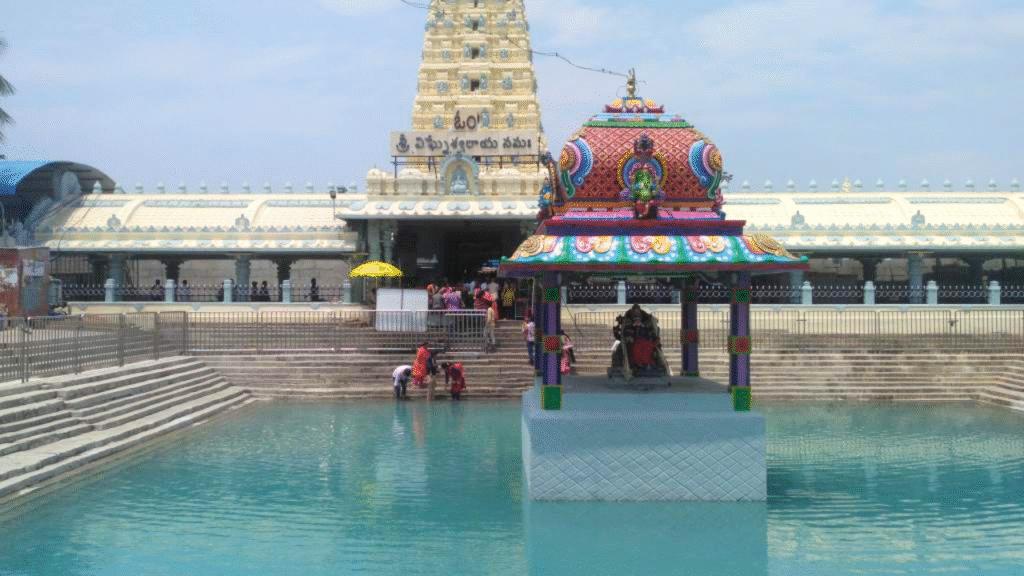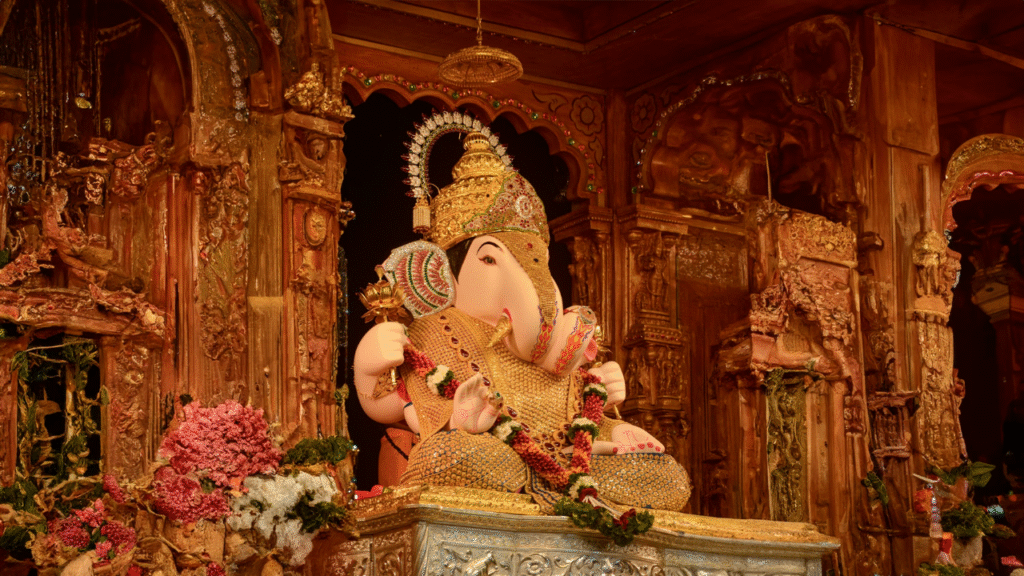The Kanipakam Temple, also known as the Sri Varasiddhi Vinayaka Swamy Temple, is one of the most revered temples dedicated to Lord Ganesha in South India. Located in Kanipakam village, near Chittoor in Andhra Pradesh, the temple holds immense spiritual and historical significance. Devotees from across India visit this shrine to seek blessings from the ever-growing idol of Lord Ganesha, which is considered to be swayambhu (self-manifested).
| Temple Name | Kanipakam Sri Varasiddhi Vinayaka Swamy Temple |
| Location | Kanipakam village, near Chittoor, Andhra Pradesh |
| Deity | Lord Ganesha (Sri Varasiddhi Vinayaka) |
| Temple Type | Hindu Temple (Swayambhu Ganesha Temple) |
| Founded By | Chola King Kulothunga Chola I (11th century) |
| Later Contributions | Vijayanagara dynasty (14th century) |
| Unique Feature | Self-manifested idol of Lord Ganesha that keeps growing in size |
| Sacred Well | Idol is seated in a well with a natural spring of water |
| Legends | Idol discovered by three brothers when water gushed out of the ground, curing their disabilities |
| Rituals & Poojas | Kalyanotsavam, Abhishekam, Modaka Seva, Laksha Kumkumarchana, Annadanam |
| Special Belief | Nyaya Pramanam – disputes resolved by oath-taking in front of the deity |
| Main Festivals | Vinayaka Chaturthi, Brahmotsavam (21 days), Ugadi, Deepavali, Sankranti, Maha Shivaratri |
| Significance | Removes obstacles, grants prosperity, idol considered to be ever-growing, water believed to have healing powers |
| Architecture | Dravidian style with beautifully carved gopurams |
| How to Reach | 12 km from Chittoor, 75 km from Tirupati Airport |
| Best Time to Visit | Festivals (Vinayaka Chaturthi & Brahmotsavam) or Nov–Feb for pleasant weather |
| Facilities | Annadanam, prasadam counters, guest houses, cloakrooms, nearby hotels and lodges |
Historical Background
The Kanipakam Temple dates back to the 11th century and was originally constructed by Chola king Kulothunga Chola I. The temple later received renovations and additions during the reign of the Vijayanagara dynasty in the 14th century. The architectural style reflects the Dravidian tradition, with intricate carvings and a beautifully designed sanctum. Over the centuries, the temple has gained prominence for its miraculous presiding deity and divine energy.
The Legend of Kanipakam
The word Kanipakam is derived from two Telugu words – Kani meaning “wetland” and Pakam meaning “flow of water.” The temple’s legend is deeply rooted in divine miracles.
According to the story, three brothers who were mute, deaf, and blind decided to dig a well to fetch water for farming. While digging, their tool hit a stone, and suddenly, water gushed out of the well. Astonishingly, the three brothers were cured of their disabilities instantly. The stone was later found to be the self-manifested idol of Lord Ganesha, and the well is still present within the temple premises.
One of the unique aspects of this temple is that the idol of Lord Ganesha is believed to be growing in size every year. Even today, the idol is seen rising beyond its frame, which adds to the divine mystery of Kanipakam.
Architecture of the Temple
The Kanipakam Temple is built in the classic Dravidian style. The gopuram (tower) at the entrance showcases beautiful carvings of deities and mythological tales. The sanctum sanctorum houses the swayambhu idol of Lord Ganesha, which is seated in a well filled with water. Devotees can witness the natural spring that surrounds the idol, symbolizing purity and divine energy.
Inside the temple, the atmosphere is serene and spiritual, with rhythmic chants of Vedic hymns enhancing the divine ambiance. The temple also has shrines dedicated to Sri Manikanteswara Swamy and Sri Varadaraja Swamy, which add to its religious significance.
Rituals and Poojas
The daily rituals and special poojas at Kanipakam Temple attract thousands of devotees. Some of the prominent offerings include:
- Kalyanotsavam – A special ritual symbolizing the divine wedding of Lord Ganesha.
- Abhishekam – Sacred bath offered to the deity with milk, honey, and sandalwood.
- Annadanam – Distribution of free meals to devotees, which is a highly respected service in the temple.
- Special Sevas – Devotees can perform offerings such as Modaka Seva and Laksha Kumkumarchana to please Lord Ganesha.
One of the most striking aspects of the temple rituals is the practice of Nyaya Pramanam, a unique method of resolving disputes. People with disagreements or legal issues take an oath before Lord Ganesha at this temple, and it is believed that divine justice prevails.
Festivals Celebrated
The temple celebrates several festivals with great devotion and grandeur:
Brahmotsavam
The Brahmotsavam festival, held annually, is the most important celebration at Kanipakam Temple. It usually lasts for 21 days, beginning on Vinayaka Chaturthi. Devotees throng the temple during this period to witness the colorful processions, cultural performances, and spiritual rituals.
Vinayaka Chaturthi
Being a Ganesha temple, Vinayaka Chaturthi is celebrated with unmatched enthusiasm. The temple is beautifully decorated with flowers and lights, and thousands of devotees offer prayers and sweets, especially modaks, to Lord Ganesha.
Other Festivals
Ugadi, Deepavali, Sankranti, and Maha Shivaratri are also celebrated with special poojas and festivities at the temple.
Significance of Kanipakam Temple
The Kanipakam Temple is not just a place of worship but also a center of divine justice and miracles. The ever-growing idol of Lord Ganesha makes it a unique and mystical pilgrimage site. It is believed that offering prayers here removes obstacles, grants prosperity, and resolves disputes.
The temple’s sacred water is also considered to have healing powers. Many devotees carry it back home, believing it to bring peace and blessings to their families.
How to Reach Kanipakam Temple
Kanipakam Temple is well connected by road, rail, and air:
- By Road: The temple is about 12 km from Chittoor town and can be easily reached by buses, taxis, and private vehicles.
- By Rail: The nearest railway station is Chittoor Railway Station, around 12 km away.
- By Air: The nearest airport is Tirupati Airport, about 75 km from Kanipakam.
Best Time to Visit
The temple can be visited throughout the year, but the best time is during Vinayaka Chaturthi and Brahmotsavam, when the temple is decorated magnificently, and the festive spirit is at its peak.
For devotees seeking a peaceful darshan, the months of November to February are ideal due to pleasant weather.
Accommodation and Facilities
Several accommodation options are available in Chittoor and Tirupati, ranging from budget hotels to comfortable lodges. The temple also provides guest houses for pilgrims. Facilities like Annadanam, prasadam counters, and cloakrooms make it convenient for visitors.



